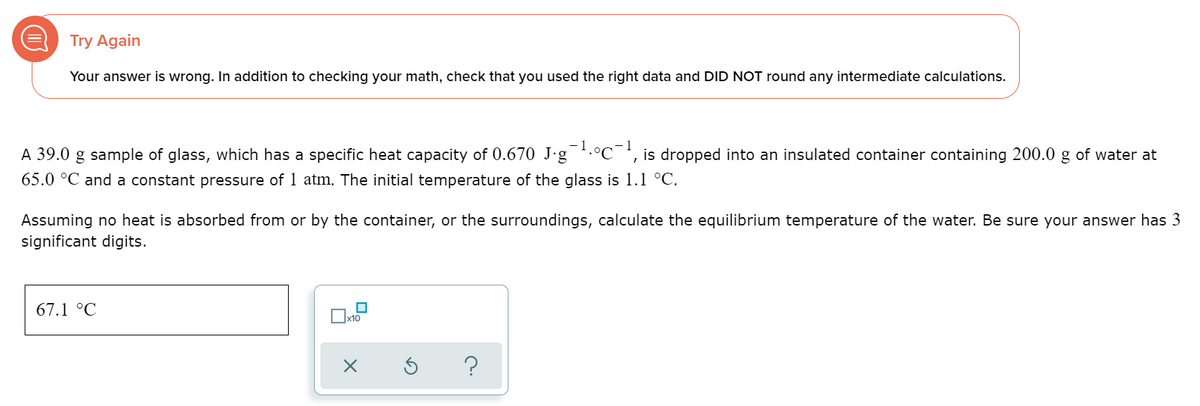A 39.0 g sample of glass, which has a specific heat capacity of 0.670 J-g¯+.°C', is dropped into an insulated container containing 200.0 g of water at 65.0 °C and a constant pressure of 1 atm. The initial temperature of the glass is 1.1 °C. Assuming no heat is absorbed from or by the container, or the surroundings, calculate the equilibrium temperature of the water. Be sure your answer has 3 significant digits.
A 39.0 g sample of glass, which has a specific heat capacity of 0.670 J-g¯+.°C', is dropped into an insulated container containing 200.0 g of water at 65.0 °C and a constant pressure of 1 atm. The initial temperature of the glass is 1.1 °C. Assuming no heat is absorbed from or by the container, or the surroundings, calculate the equilibrium temperature of the water. Be sure your answer has 3 significant digits.
Chemistry & Chemical Reactivity
9th Edition
ISBN:9781133949640
Author:John C. Kotz, Paul M. Treichel, John Townsend, David Treichel
Publisher:John C. Kotz, Paul M. Treichel, John Townsend, David Treichel
Chapter5: Principles Of Chemical Reactivity: Energy And Chemical Reactions
Section: Chapter Questions
Problem 39PS: A piece of titanium metal with a mass of 20.8 g is heated in boiling water to 99.5 C and then...
Related questions
Question
100%

Transcribed Image Text:Try Again
Your answer is wrong. In addition to checking your math, check that you used the right data and DID NOT round any intermediate calculations.
-1
A 39.0 g sample of glass, which has a specific heat capacity of 0.670 J·g .°C¯', is dropped into an insulated container containing 200.0 g of water at
65.0 °C and a constant pressure of 1 atm. The initial temperature of the glass is 1.1 °C.
Assuming no heat is absorbed from or by the container, or the surroundings, calculate the equilibrium temperature of the water. Be sure your answer has 3
significant digits.
67.1 °C
Expert Solution
This question has been solved!
Explore an expertly crafted, step-by-step solution for a thorough understanding of key concepts.
This is a popular solution!
Trending now
This is a popular solution!
Step by step
Solved in 2 steps with 2 images

Knowledge Booster
Learn more about
Need a deep-dive on the concept behind this application? Look no further. Learn more about this topic, chemistry and related others by exploring similar questions and additional content below.Recommended textbooks for you

Chemistry & Chemical Reactivity
Chemistry
ISBN:
9781133949640
Author:
John C. Kotz, Paul M. Treichel, John Townsend, David Treichel
Publisher:
Cengage Learning

Chemistry & Chemical Reactivity
Chemistry
ISBN:
9781337399074
Author:
John C. Kotz, Paul M. Treichel, John Townsend, David Treichel
Publisher:
Cengage Learning

Chemistry by OpenStax (2015-05-04)
Chemistry
ISBN:
9781938168390
Author:
Klaus Theopold, Richard H Langley, Paul Flowers, William R. Robinson, Mark Blaser
Publisher:
OpenStax

Chemistry & Chemical Reactivity
Chemistry
ISBN:
9781133949640
Author:
John C. Kotz, Paul M. Treichel, John Townsend, David Treichel
Publisher:
Cengage Learning

Chemistry & Chemical Reactivity
Chemistry
ISBN:
9781337399074
Author:
John C. Kotz, Paul M. Treichel, John Townsend, David Treichel
Publisher:
Cengage Learning

Chemistry by OpenStax (2015-05-04)
Chemistry
ISBN:
9781938168390
Author:
Klaus Theopold, Richard H Langley, Paul Flowers, William R. Robinson, Mark Blaser
Publisher:
OpenStax

Chemistry for Engineering Students
Chemistry
ISBN:
9781337398909
Author:
Lawrence S. Brown, Tom Holme
Publisher:
Cengage Learning

Chemistry: The Molecular Science
Chemistry
ISBN:
9781285199047
Author:
John W. Moore, Conrad L. Stanitski
Publisher:
Cengage Learning

Chemistry: An Atoms First Approach
Chemistry
ISBN:
9781305079243
Author:
Steven S. Zumdahl, Susan A. Zumdahl
Publisher:
Cengage Learning